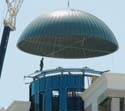With the adoption of the International Residential Code, 2006 Edition, which contains specific provisions permitting the use of unvented, conditioned attic assemblies, such attic assemblies have been growing in popularity throughout the U.S.
However, one common criticism of such assemblies is that they may result in increased roof surface temperatures that can prematurely deteriorate roof coverings, particularly bitumen-based roof coverings. Also, in some instances, manufacturers' warranties limit or exclude coverage of attic assemblies over roof deck substrates that are not properly vented.
Surface temperatures
In most instances, the use of unvented, conditioned attic assemblies results in increased roof surface temperatures when compared with temperatures of conventionally vented attic assemblies. However, it is important to keep the small temperature increases attributed to unvented, conditioned attic assemblies in perspective.
For example, the differences between roof surface temperatures in the southern and northern regions of the U.S. are significantly greater than the surface temperature differences between unvented, conditioned attic assemblies and conventionally vented attic assemblies.
Similarly, the roof surface temperature difference between a roof system's southern, sun-exposed slope and northern, shaded slope is about the same or greater than the surface temperature difference between unvented, conditioned attic assemblies and conventionally vented attic assemblies.
Although some roofing professionals acknowledge differences in roof system performance and life span between the southern and northern regions of the U.S. or on the southern slope versus the northern slope of a given roof system, asphalt shingle manufacturers do not vary their warranty provisions based on these differences. Therefore, the question is whether warranty exclusions for unvented, conditioned attic assemblies are technically justified.
Warranties
NRCA reviewed some asphalt shingle manufacturers' warranties for specific provisions or exclusions addressing unvented, conditioned attic assemblies. NRCA also conducted follow-up discussions with manufacturers' technical and/or warranty service departments to confirm its findings.
Based on its research, NRCA found CertainTeed Corp., Valley Forge, Pa.; GAF-Elk, Wayne, N.J.; IKO, Wilmington, Del.; Malarkey Roofing Products, Portland, Ore.; and Pabco Roofing Products, Tacoma, Wash., provide warranty coverage for unvented, conditioned attic assemblies with certain limitations. NRCA found the limitations differ somewhat among manufacturers and sometimes among a manufacturer's products and warranties.
Closing thoughts
Use of unvented, conditioned attic assemblies is particularly logical in hot, humid climates where buildings' air-conditioning equipment often is placed in attics.
But some asphalt shingle manufacturers specifically exclude such assemblies from their warranty coverage while other manufacturers include them in their warranties with certain limitations. It is important to realize manufacturers are free to base and structure their warranties on factors of their own choosing and manufacturers' warranty requirements and language sometimes change.
If you are involved with or considering roofing projects using asphalt shingles on unvented, conditioned attic assemblies, I encourage you to contact the asphalt shingle manufacturer being considered regarding its warranty coverage and limitations or exclusions applicable to unvented, conditioned attic assemblies.
Mark S. Graham is NRCA's associate executive director of technical services.



